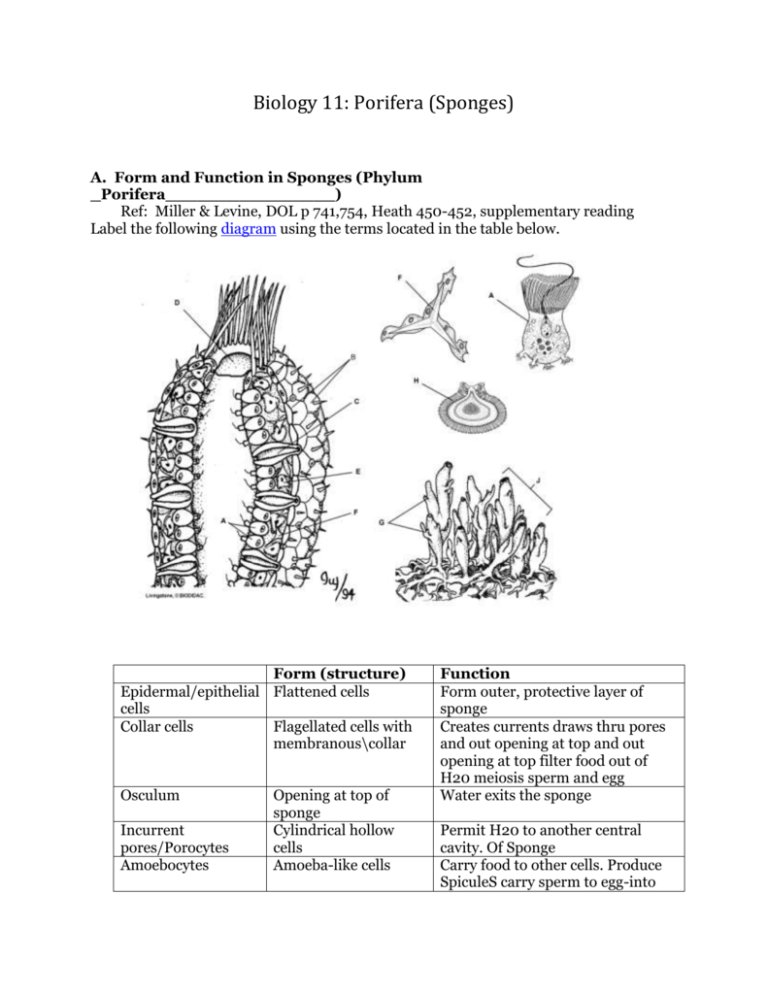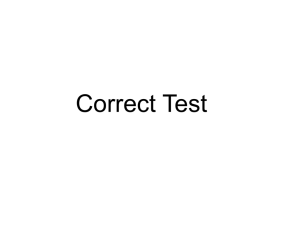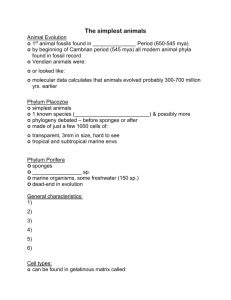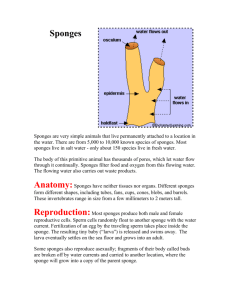Biology: Porifera (Sponges) Worksheet
advertisement

Biology 11: Porifera (Sponges) A. Form and Function in Sponges (Phylum _Porifera________________) Ref: Miller & Levine, DOL p 741,754, Heath 450-452, supplementary reading Label the following diagram using the terms located in the table below. Form (structure) Epidermal/epithelial Flattened cells cells Collar cells Flagellated cells with membranous\collar Osculum Incurrent pores/Porocytes Amoebocytes Opening at top of sponge Cylindrical hollow cells Amoeba-like cells Function Form outer, protective layer of sponge Creates currents draws thru pores and out opening at top and out opening at top filter food out of H20 meiosis sperm and egg Water exits the sponge Permit H20 to another central cavity. Of Sponge Carry food to other cells. Produce SpiculeS carry sperm to egg-into Biology 11: Porifera (Sponges) Spicules Adult sponge Buds Gemmules 1. Spiked (thin, spiny) . Structures Sessile upright filter feeder Juvenile sponges A group of amoebo Cytes with a hard outer covering other cells meiosis sperm egg Can differentiate into other cells Provide skeletal support and protection against predators Hermaphrodite can produce eggs and Sperm Asexual reproduction clones of adult Asexual reproduction method Feeding and Digestion •sponges are different from all other animals in that they lack a _mouth & gut -filter feeders - sift microscopic pieces of food from Water as it passes through •_ collar cells have membranous collar that traps food particles - food then ingested by phagocytosis •digestion is termed intracellular because it takes place inside cells •collar cells may digest food or pass it on to _amoebo Cytes •amoebocytes creep through mesenchyme- distribute digested food throughout body 2. Roles of Water Flow (describe) a) Respiratory –delivers 02 to cells & removes CO2 b) Excretory –carries metabolic wastes away from cells (NH3) c) Internal Transport –carries nutrients, gases, wastes to & from cells d) Sexual Reproduction –transports gametes-larvae out of body & into another sponge _ Biology 11: Porifera (Sponges) 3. Reproduction Sexual Reproduction Label the following diagram with the following terms: sperm, egg, larva, flagella, new sponge. Sperm Egg Larva with flagella Larva New sponge a) Eggs & sperm are produced by what cells of a sponge? _ collar cells & amoebo cytes that undergo meiosis b) Where in the sponge shown in the diagram does fertilization occur? In mesenchyme between epidermal and collar cells c) What is a hermaphrodite? Are the sponges in the diagram hermaphrodites? Explain your answer. An organism that produces both eggs & . sperm probably is a hermaphrodite although they produce egg and spermat different times to prevent self-fertilization Biology 11: Porifera (Sponges) d) Describe the larva that is produced by sexual reproduction in sponges. Made up of many cells, flagellated at one end therefore motile e) Are the sponges in the diagram sessile? Why or Why not? Yes, attached to a substrate f) How do sperm enter a sponge? In water that moves through porocytes (pores) g) How are sperm transported to eggs within a sponge? They are surrounded by amoebo cytes which carry them to eggs h) Are the cells of the larva 2n cells or n cells? Explain your answer. 2n larva formed by repeated mitotic divisions Zygote is 2 n so every cell that follows is 2n also Asexual Reproduction •sponges reproduce asexually by budding or by production of gemmules a) Budding (describe process) A new sponge begins as an outgrowth (bud) on adult, gradually develop adult characteristics, fall off, begins life as a new individual b) Gemmules (describe structure & function) Function: to survive unfavorable environmental conditions B. Diversity in Sponges 1. Study “Porifera” chart on back wall & see Heath, p. 452. a) List at least four ways in which sponges differ from each other. Shape, size, color, Skeletal support. SpiculeS. Can be made of silicates (glass) orCa CO3 could be protein (spongin), tunnel branching, fresh H20 or marine b) What characteristics are used to classify sponges? Internal branching patterns or material that makes up skeleton C. Roles of Sponges 1. Roles - List and describe Important in nutrient cycles Filter enormous amounts of H2O symbiotic relationship with bacteria that fix N from gas in water and form NH3 Biology 11: Porifera (Sponges) released by sponges Key to health of coral reeefs. Food for nudibranchs and some molluscs Commensalistic: provide homes for other organisms 2. How are sponges proving useful to medical science? Cancer fighting compounds, actually from bacteria living in sponges rather than spoge themselves. These invertebrate animals offer possibilities to develop medication to fight some of the most important diseases in the world. Right now, three quarters of all patented bio-active material for cancer medication comes from sponges 3. In what ways do sponges differ from all other animals? Cellular level of organization (only have specialized cells) No mouth or gut, No germ layers. Blastula No Nerve cells or contractile cells






